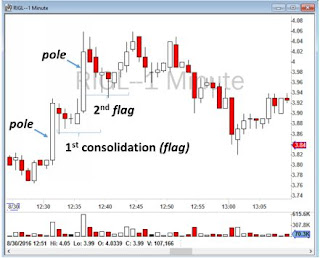Bull Flag Momentum
In day trading, Bull Flag is a momentum fast execution strategy that usually works great on low float stocks (Chapter 4). I believe Bull Flag is a scalping strategy because these flags won’t last long and you must scalp the trade - get in quickly, take your profit, and then get out.
Example of Bull Flag formation with one consolidation period.
This pattern is named Bull Flag because it resembles a flag on a pole. In Bull Flag, you have several large candles going up (like a pole), and you also have a series of small candles moving sideways (like a flag), or, as we day traders say, “consolidating”. Consolidation means that the traders who bought stocks at a lower price are now selling and taking their profits. Although that is happening, the price does not decrease sharply because buyers are still entering into trades and the sellers are not yet in control of the price. Many traders will miss purchasing the stock before the Bull Flag starts. It is risky to buy stock when the price is increasing. That’s called “chasing the stock”. Professional traders aim to enter the trade during quiet times and take their profits during wild times. That, of course, is the total opposite of how amateurs trade. They jump in or out when stocks begin to run, but grow bored and lose interest when the prices are, shall I say, sleepy.
Chasing the stocks is an account killer for beginners. You must wait until the stock finds its high point, and then wait for the consolidation. As soon as the price breaks up in the consolidation area, you can begin purchasing stocks.
Usually a Bull Flag will show several consolidation periods. I enter in only the first and second consolidation periods. Third and higher consolidation periods are risky because the price has probably been very extended in a way that indicates that the buyers will soon be losing their control. Let’s study an example of a Bull Flag of RIGL on August 30, 2016.
Example of Bull Flag formation with two consolidation periods on RIGL.
This is an example of two Bull Flag Patterns. It is normally hard to catch the first Bull Flag, and you will probably miss it, but your scanner should alert you to it. Let’s look at an example from my scanner in this time period:
Example of my intraday Bull Flag Strategy.
As you can see, my scanner showed RIGL at 12:36:15 pm. As soon as I saw that, I realized that there was also a very high relative volume of trading, which made this a perfect setup for day trading. I waited for the first consolidation period to finish and, as soon as the stock started to move towards its high for the day, I jumped into the trade. My stop loss would be the breakdown of the consolidation period. I marked my exit and entry in the picture below. As you can see, if you had wanted to wait for a second consolidation period in hope of the third Bull Flag, you would probably have been stopped out. That is why I usually enter the first and second Bull Flags, but not the third one.
Entry, stop and exit of a Bull Flag Strategy on RIGL.
To summarize my trading strategy:
- When I see a stock surging up (either on my scanner or when advised by someone in our chatroom), I patiently wait until the consolidation period. I do not jump into the trade right away (you will recall that is the dangerous act of “chasing”).
- I watch the stock during the consolidation period. I choose my share size and stop and exit strategy.
- As soon as prices are moving over the high of the consolidation candlesticks, I enter the trade. My stop loss is the break below the consolidation periods.
- I sell half of my position and take a profit on the way up. I bring my stop loss from the low of the consolidation to my entry price (break-even).
- I sell my remaining positions as soon as my target hits or I feel that the price is losing steam and the sellers are gaining control of the price action.
As I mentioned, many people, including myself, buy only at or near the breakout (similar to the ABCD Pattern). The Bull Flag is essentially an ABCD Pattern that will happen more on low float stocks. It’s fast and it will fade away more quickly. Therefore, it is more or less a Momentum Scalping Strategy. Scalpers buy when a stock is running. They rarely like to buy during consolidation (during that waiting and holding phase). These types of stocks usually drop quickly and brutally so it is important for you to jump only when there is a confirmation of breakout. Waiting for the stocks to break the top of a consolidation area is a way of reducing your risk and exposure time. Instead of buying and holding and waiting, which increases exposure time, scalpers just wait for the breakout and then send their order. Get in, scalp, and get out quickly. That’s the philosophy of momentum scalpers:
- Get in at the breakout
- Take your profit
- Get out of the way
The Bull Flag Pattern is found within an uptrend in a stock. The Bull Flag is a long-based strategy. You should not short a Bull Flag. I personally don’t trade much momentum. It is a risky strategy and beginners should be very careful trading these. If you choose to, trade only small size and only after sufficient practice in simulators. You will also need a super-fast execution system for scalping.



